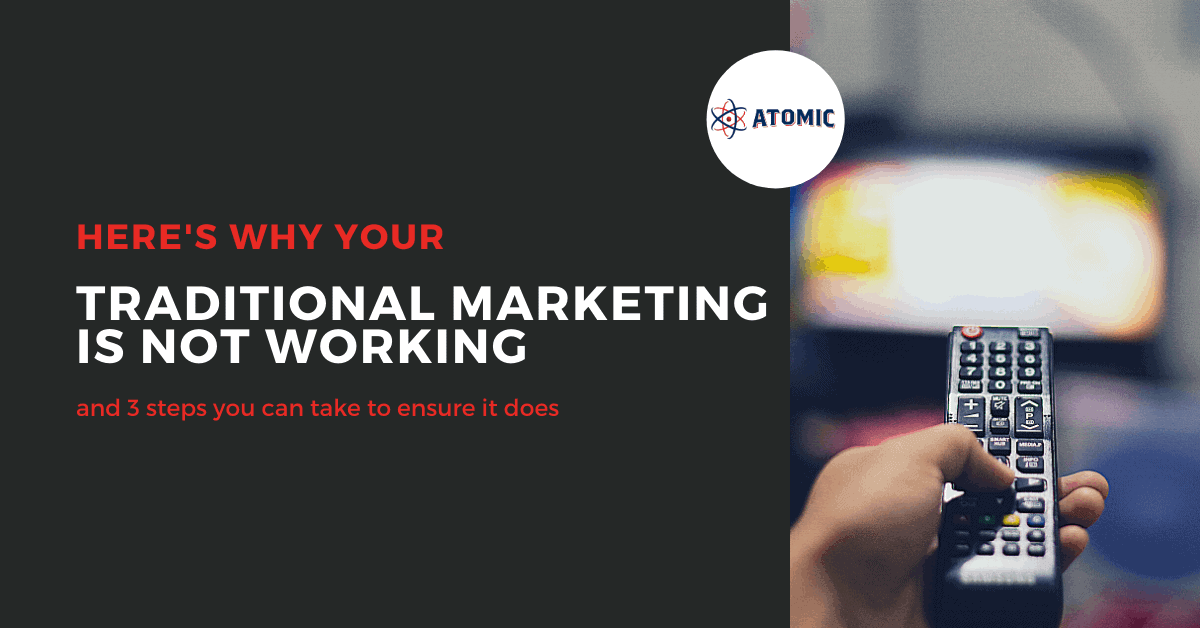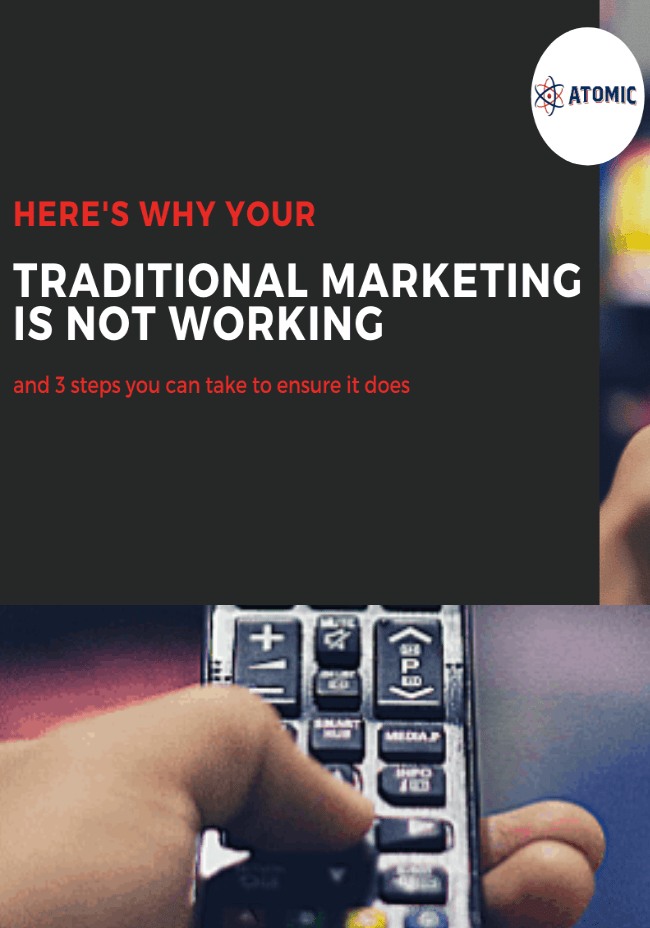Here’s why your traditional marketing is not working, and 3 steps you can take to ensure it does
Here’s why your traditional marketing is not working, and 3 steps you can take to ensure it does
BY ATOMIC | JUN 28, 2020

By: Gayle Rogers, Founder of Atomic
Let’s be real. Measuring the effectiveness of traditional advertising is spotty at best. While the whole idea of traditional marketing is that you can reach a large number of people, advertisers have heavily relied upon two main metrics: reach and frequency.
How many people did I reach, what percentage of the population is in my target, and how many times did I hit them? (Yeah, you have gross rating points, total rating points, and stuff like that, but I’m sure we can still agree your measurement is limited.)
Of course, as time went on, we wanted better ways to measure our traditional marketing efforts and began doing thighs like custom phone numbers and dedicated URLs to track the effectiveness of particular spots. And really, that’s how we’re still measuring effectiveness today.
The problem?
This is basing the effectiveness of the ad simply on the number of responses or how many people heard your message. These metrics and tracking methods don’t even begin to take into account how these efforts affected certain points of the customer journey.
And no, a “good feeling” isn’t a measurement for advertising effectiveness
I tell a client that their ads started running last week and all too often I hear them say, “I can feel it.” Well, I hate to tell you, but that’s not a measurement for advertising effectiveness in any way, shape, or form.
So how do you effectively measure traditional advertising like cable TV, billboards, and print ads? I’ll show you. But first thing’s first.
Step One: Decide if Traditional Media is the Right Channel to Reach Your Marketing Goals
Before you start spending a bunch of money on traditional media ads, you need to understand who you’re going after, why you’re going after them, where you are now, and what you hope to achieve.
Once you’re able to answer those questions, it’s time to look at each medium and its strength.
Which channels are going to best help you reach your target audience and achieve your goals?
Most would agree that cable TV’s biggest strength is going to be awareness – you can reach a huge amount of people, and if you’ve got a big enough budget, you can reach them a certain number of times.
Is a high-reach medium like cable TV going to help you reach your marketing goals? If your goal is to increase brand awareness because you have a product that no one has heard of before, then maybe the answer is yes.
If your main goal is to get customers looking for your type of product or service to consider your business, maybe you should go with Paid Search or Search Engine Optimization. If you want to educate customers on your product, maybe consider a content marketing strategy.
You get the point.
Your medium has to match your goals and that’s exactly why this first step is essential. To get what you want out of your advertising, you must first know for sure if you’re using the right medium. If not, you’re going to end up with less money and even more disappointment.
Step Two: Map Out the Customer Journey
Once you choose the right medium, the only way you’re going to know if it is or isn’t effective is if you’ve properly mapped out the entire journey your customers’ take before and (long) after the sale.
What point of the customer journey is this advertising going to impact? Where do you need the most help when it comes to converting potential customers?
You’ve got to know your entire customer journey from awareness to consideration to preference and intent – all the touchpoints where a potential customer is going to interact with your business. This is the traditional ad funnel, and many businesses can fit in there in some way, but most need a custom funnel where they map out the entire journey of their customers.
And don’t stop at purchase!
Unless you’re a lawyer who typically has one sale per customer, it needs to continue after the sale. It needs to stop at referral, repurchase, or service if that applies to your product. You need to track all these pieces over time and know your baselines.
Let’s say your goal is awareness so you run an ad on TV. How are you going to measure awareness after your ad runs? If you know that when 100 people are aware of your product that 20 are more likely to prefer your product, you’re a lot better equipped to know if that campaign was effective.
Step Three: Measure, measure, measure
Last, but not least, you’ve got to decide how you’re going to measure the effectiveness of your ads. Just because you started running an ad at the time when your customers typically start to buy, doesn’t necessarily mean the ad worked. It could just mean seasonality kicked in so don’t fall victim to this perceived effectiveness like so many others.
Beyond the basics like reach and frequency, and the number of responses, there are a few ways to measure the effectiveness of your traditional advertising, and that’s through surveys, by holding focus groups and analyzing website traffic.
Your website traffic can tell you a lot.
If you’re targeting certain cities, you can look at traffic to your website specifically from those cities. If you’re running a TV ad at a certain time, you can look to see if your traffic increases during that exact time frame. From there, you can see what percentage of that traffic engaged with the targeted product/service, made a purchase, called your business, submitted a form, or any other conversions you deem worthy.
See if your message hit home through surveys or focus groups.
Go in and survey the area in which your ads were targeted and literally ask people questions like “Are you familiar with this brand?” or “What resonates with you now that you are familiar with it?” This way, you’ll truly know if your message hit home and made an impact.
Now Is the Time to Start Measuring Your Traditional Advertising
One of my favorite quotes is from The Shawshank Redemption where Morgan Freeman says, “You can get busy livin’, or you can get busy dyin’.”
The same principle applies to marketing and business growth. If you’re doing the same thing you’ve always done, you’re going to get what you’ve always had. You’ve got to be brave enough to make a change.
If you’re comfortable where you are and want what you always had, eventually someone who’s smarter, braver, or more creative is going to come along and steal your market share. So while you may be good with sitting idle, just know that not everyone else is
If your business has been advertising through traditional media for years simply because you think it works, now is really a great time to evaluate.
Everyone’s on the elimination diet where they’re taking all the foods out of their diet (all their marketing), but this allows you to introduce marketing campaigns and channels one at a time to figure out what you’re allergic to, (which marketing efforts aren’t working.)
Either way, you have to find a way to implement some strategic testing in order to get enough statistical data to make a significant assertion as to whether your traditional marketing efforts are bringing in customers. Or wasting your money.

